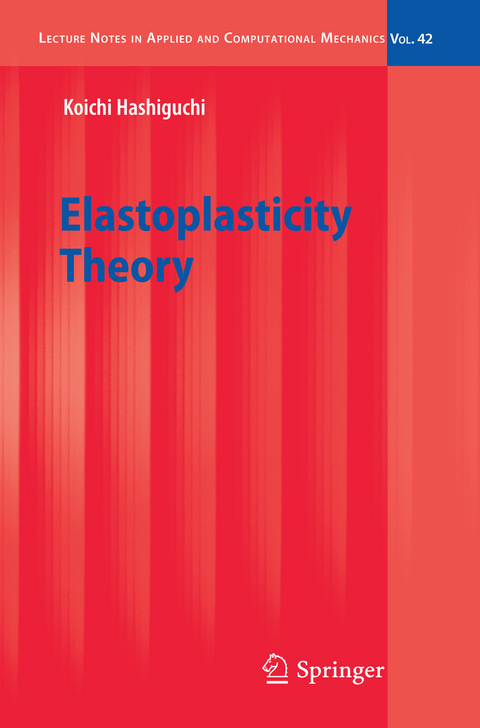
Elastoplasticity Theory
Seiten
2010
Springer Berlin (Verlag)
9783642101328 (ISBN)
Springer Berlin (Verlag)
9783642101328 (ISBN)
This book details the mathematics and continuum mechanics necessary as a foundation of elastoplasticity theory. It explains physical backgrounds with illustrations and provides descriptions of detailed derivation processes.
Contents Recent advancements in the performance of industrial products and structures are quite intense. Consequently, mechanical design of high accuracy is necessary to enhance their mechanical performance, strength and durability. The basis for their mechanical design can be provided through elastoplastic deformation analyses. For that reason, industrial engineers in the fields of mechanical, civil, architec- ral, aerospace engineering, etc. must learn pertinent knowledge relevant to elas- plasticity. Numerous books about elastoplasticity have been published since "Mathema- cal Theory of Plasticity", the notable book of R. Hill (1950), was written in the middle of the last century. That and similar books mainly address conventional plasticity models on the premise that the interior of a yield surface is an elastic domain. However, conventional plasticity models are applicable to the prediction of monotonic loading behavior, but are inapplicable to prediction of deformation behavior of machinery subjected to cyclic loading and civil or architectural str- tures subjected to earthquakes. Elastoplasticity has developed to predict defor- tion behavior under cyclic loading and non-proportional loading and to describe nonlocal, finite and rate-dependent deformation behavior.
Contents Recent advancements in the performance of industrial products and structures are quite intense. Consequently, mechanical design of high accuracy is necessary to enhance their mechanical performance, strength and durability. The basis for their mechanical design can be provided through elastoplastic deformation analyses. For that reason, industrial engineers in the fields of mechanical, civil, architec- ral, aerospace engineering, etc. must learn pertinent knowledge relevant to elas- plasticity. Numerous books about elastoplasticity have been published since "Mathema- cal Theory of Plasticity", the notable book of R. Hill (1950), was written in the middle of the last century. That and similar books mainly address conventional plasticity models on the premise that the interior of a yield surface is an elastic domain. However, conventional plasticity models are applicable to the prediction of monotonic loading behavior, but are inapplicable to prediction of deformation behavior of machinery subjected to cyclic loading and civil or architectural str- tures subjected to earthquakes. Elastoplasticity has developed to predict defor- tion behavior under cyclic loading and non-proportional loading and to describe nonlocal, finite and rate-dependent deformation behavior.
Tensor Analysis.- Motion and Strain (Rate).- Conservation Laws and Stress Tensors.- Objectivity and Corotational Rate Tensor.- Elastic Constitutive Equations.- Basic Formulations for Elastoplastic Constitutive Equations.- Unconventional Elastoplasticity Model: Subloading Surface Model.- Cyclic Plasticity Model: Extended Subloading Surface Model.- Viscoplastic Constitutive Equations.- Constitutive Equations of Metals.- Constitutive Equations of Soils.- Corotational Rate Tensor.- Localization of Deformation.- Numerical Calculation.- Constitutive Equation for Friction.
| Erscheint lt. Verlag | 22.10.2010 |
|---|---|
| Reihe/Serie | Lecture Notes in Applied and Computational Mechanics |
| Zusatzinfo | XVI, 416 p. 127 illus. |
| Verlagsort | Berlin |
| Sprache | englisch |
| Maße | 155 x 235 mm |
| Gewicht | 647 g |
| Themenwelt | Informatik ► Theorie / Studium ► Künstliche Intelligenz / Robotik |
| Mathematik / Informatik ► Mathematik ► Wahrscheinlichkeit / Kombinatorik | |
| Naturwissenschaften ► Physik / Astronomie ► Mechanik | |
| Technik ► Maschinenbau | |
| Schlagworte | Constitutive equation of friction • Constitutive equations of metals and soils • Continuum Mechanics • Elastoplastic constitutive equation • Mechanics • Plasticity • Plasticity theory • Viscoplastic constitutive equation |
| ISBN-13 | 9783642101328 / 9783642101328 |
| Zustand | Neuware |
| Informationen gemäß Produktsicherheitsverordnung (GPSR) | |
| Haben Sie eine Frage zum Produkt? |
Mehr entdecken
aus dem Bereich
aus dem Bereich
Eine praxisorientierte Einführung
Buch | Softcover (2025)
Springer Vieweg (Verlag)
CHF 53,15
Buch | Softcover (2025)
Reclam, Philipp (Verlag)
CHF 11,20
Eine kurze Geschichte der Informationsnetzwerke von der Steinzeit bis …
Buch | Hardcover (2024)
Penguin (Verlag)
CHF 39,95


